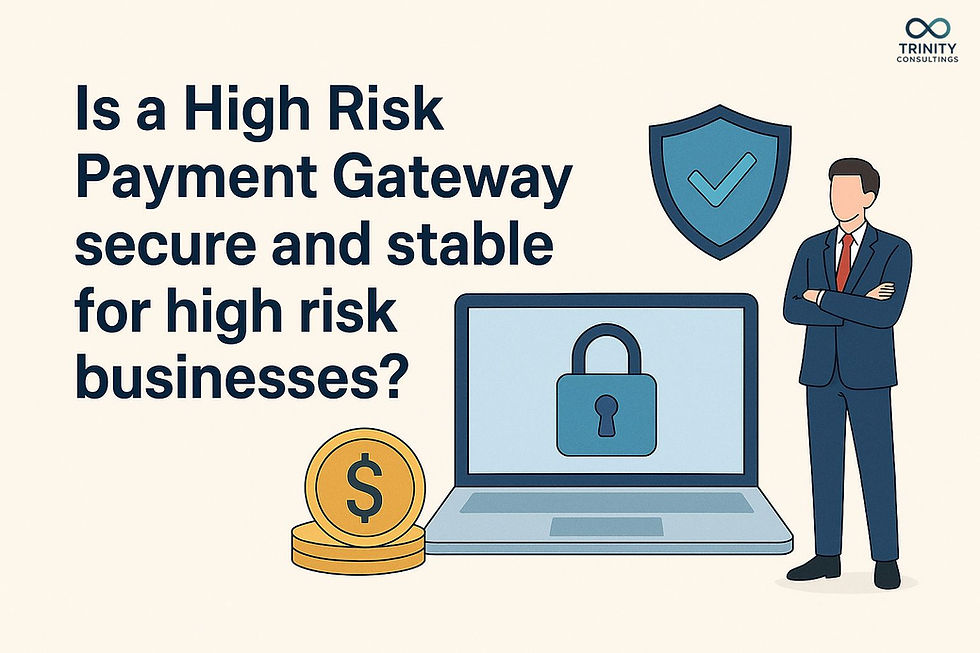Is a High Risk Payment Gateway secure and stable volumes for high risk business?
- Trinity Consultings
- Oct 6
- 4 min read
With the advent of e-commerce, companies live or die by the power of their ability to accept payments securely and promptly. Not all companies are treated equally favorably by legacy payment processors, though. Companies that sell into more chargeback-rich industries, fluctuating amounts of sales, or regulatory in nature are typically high-risk companies. Such companies find it difficult to receive consistent and stable volumes of transactions. This is where a High Risk Payment Gateway comes in as an essential tool—helping them maintain seamless operations while curtailing instability and fraud.
Understanding What Makes a "High-Risk" Business
High-risk merchant is a business firm with higher possibilities of acquiring chargebacks, fraud, or disputes. This term is not necessarily a reflection of the moral nature of the firm; instead, it is more a reflection of the transactions and kind of market for the firm. Some typical examples of high-risk firms are online gambling, forex trading, travel agency businesses, entertainment, content, subscription models, selling and nutraceuticals.
These merchants have more opportunities of larger transaction volumes, maintain international merchant business, and accept different modes of payments from the customers. These kinds of merchants are generally avoided by traditional payment processors because there is a risk of exposure of money. A High-Risk Payment Gateway is then a special gateway to facilitate riskless, uninterrupted, and secure processing of transactions.
The Role of a High Risk Payment Gateway
A High-Risk Payment Gateway is a reliable gateway between the acquiring bank and merchant website that handles authorization and payment transaction. It is more robust than an ordinary gateway and developed with more robust functionality to manage more elevated transaction risk, international traffic, and advanced compliance needs.
These gateways provide stability in payment volume by managing volatile transaction patterns and safeguarding businesses against fraud or chargeback. They are architecturally designed on flexibility and reliability—two fundamental aspects of high-risk merchants relying on steady revenue flow.
Providing Security with Leading-Edge Technology
Security is the core of any payment gateway, but to high-risk merchants, it's even more. High-Risk Payment Gateways utilize the latest security technologies like:
End-to-End Encryption: Secures sensitive payment data in transit, and customer data is never exposed at any point.
Tokenization: Swaps payment data with safe tokens, minimizing the chances of data theft and fraud.
AI-Powered Fraud Protection: Real-time scans transactions, and identifies suspicious activity prior to influencing business.
3D Secure Authentication: Provides an additional online transaction authentication, minimizing unauthorized transactions.
PCI DSS Compliance: Provides compliance with international payment card data security standards, which safeguards the consumer and the merchant as well.
By doing so, a High-Risk Payment Gateway ensures that all transactions pass through several layers of safety, reducing the risk to a minimum and earning customer trust.
Stability in Payment Volumes
The largest problem for high-risk merchants is sustaining stable volume of transactions. Chargebacks, seasonal fluctuations, and cross-border payments threaten the continuity and cash flow. A High Risk Payment Gateway of Trinity Consultings overcomes this problem with:
Multiple Acquirer Connections: With the link to several banks and acquirers, these gateways share the load of transactions cost-effectively, avoiding downtime or unexpected shutdown.
Load Balancing: Transactions are dynamically allocated to the most responsive and stable processing streams.
High Approval Rates: Routing optimization leads to fewer declined transactions, allowing businesses to enjoy a smooth cash flow.
Chargeback Management Tools: Early Warning and Prevention tools allow chargeback ratios to be managed, keeping accounts stable and reputation intact.
This synergy of smart routing and risk handling enables organizations to be reachable at all times even under load conditions without any form of impalement in processing huge volumes of transactions.
Global Accessibility and Multi-Currency Support
One of the best features of a High-Risk Payment Gateway is that it can be accessed worldwide. Most high-risk merchants are making sales to international customers, and as a result, multi-currency and cross-border functionality is required. These gateways can process payments in more than one currency and provide:
Currency Conversion Tools: Automatically convert payments to the merchant's home currency.
Regional Payment Support: Regional payment type support such as digital wallets, bank transfers, and alternative payments.
International Compliance Support: Compliance support with local finance regulation and fraud prevention requirements.
It not only increases revenue but also gives companies more stability and scalability.
Customer Trust Building
For high-risk industries, trust will be the largest hindrance to growth. Customers will shy away from transactions with high-risk-seeming industries. A safe payment gateway that is also trusted such as a High-Risk Payment Gateway has the ability to alter perception. Standard payment methods, open transaction handling, and security audits enable companies to be in a position to offer higher credibility and build customer trust.
Bypassing Common Challenges
Though High-Risk Payment Gateways have many benefits, they should be utilized by businesses strategically. Some gateways will cost merchants a slightly higher fee because they bear more risk. Merchants will also need to be honest in their transactions and comply with gateway rules in order to not have their accounts held or face fines.
Businesses should do the following to succeed in the long run:
Monitor volumes of fraud and chargebacks on a consistent basis.
Have current payment information and systems in place.
Integrate gateway providers with accommodating customer service and negotiable contract terms.
Provide refund and dispute resolution policies to accompany good customer relationships.
Conclusion
High Risk Payment Gateway is not a payment type—it's a lifeline to businesses that operate extremely high-risk business. It provides security, stability, and scalability to merchants, enabling them to manage risk and reap stable transaction volumes. With superior fraud protection, worldwide access, and smart transaction routing, these gateways enable high-risk companies to do business confidently and reliably.
A secure High Risk Payment Gateway is the protection a high-risk company requires to prosper in a world of uncertainty, earn safe money, and establish credibility in the current global business environment.





Comments